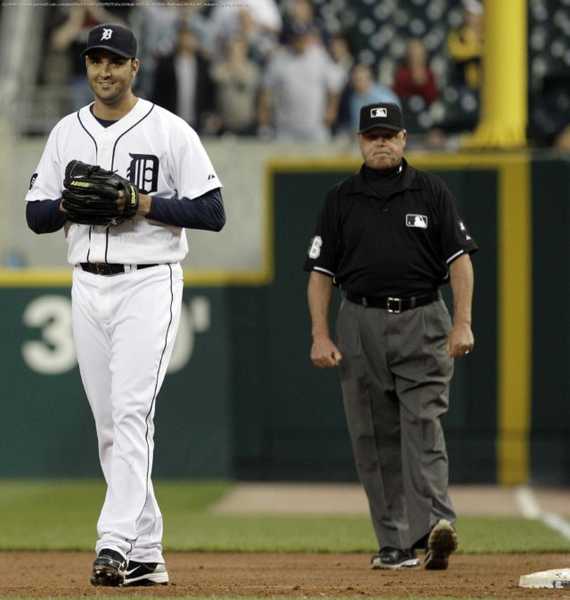It was a random Wednesday when Eric Wayne and his friends were running late. This was 10 years ago, driving 2½ hours east to Detroit…
It was a random Wednesday when Eric Wayne and his friends were running late.
This was 10 years ago, driving 2½ hours east to Detroit from Grand Rapids, where they looked at the clock — it was past 4 p.m. They had a pair of tickets to that night’s Detroit Tigers game — Adam Everett was pictured — and thought, “Why not?”
The Tigers were hosting the Indians at Comerica Park that night. It was June 2,2010. A beautiful day, with temperatures in the mid-70s. Armando Galarraga, an inconsistent right-hander who was on shaky ground in the starting rotation, was set to face righty Fausto Carmona, who years later would be known as Roberto Hernandez.
Wayne, who years later would be known as «Phil Coke’s Brain» on Twitter, had yet to create the digital persona. He spent the drive talking with friends. To his recollection, they did not talk about Galarraga. And they definitely did not talk about Jim Joyce, who at about this time was driving north from Toledo to Detroit.
Joyce, a little-known yet highly respected umpire, had cracked a beer at his father’s tombstone a few hours earlier. He would umpire at first base that night.
“So we book it down there, it was me and my wife, my friend Brian, and a couple of friends of ours, and it’s just, we did not take the game so seriously,” Wayne said. “It was Galarraga pitching, after all.”
And when Galarraga took the mound that night, no one could have imagined what the next hour and 44 minutes would bring, much less how it would be felt a decade later.
After losing a spring training battle to Dontrelle Willis for the fifth rotation spot, Galarraga pitched solidly at Triple-A Toledo, posting a 4.35 ERA in seven starts before being recalled to Detroit in mid-May. He struggled in his second start and pitched out of the bullpen in his next outing, but now had a big opportunity: Willis was traded to the Diamondbacks on June 1, opening a spot in the starting rotation.
Rick Knapp, Tigers pitching coach: «I can remember walking in and Jim (Leyland, Tigers manager) would always look at me and go like, ‘What’s (Galarraga) looking like today, Ricky?’ and I said, ‘Yeah, well…. It’s…. We’ll see what we got. If he can hit his spots, we’ll be all right, I guess, and hopefully we’ll have a chance to win the game.’ «
Alex Avila, Tigers catcher: «Early in that game, he had probably one of the best fastballs he’s had as far as life on the fastball and the ability to locate it. He was anywhere up to like 94-95 (mph), kind of sitting at 92-94, which, usually, he was 90-91. We pretty much just used his fastball in the first four innings because there was no need to go to anything else because his fastball was that good.»
Rod Allen, Fox Sports Detroit analyst: «And he wasn’t even sweating. I might have even made mention that effect during the course of the broadcast, that it just looked like it was so effortless.»
Jeff Jones, Tigers bullpen coach: «It happened really fast, because Cleveland was really swinging that day. They weren’t taking a lot of pitches, the defense was really good, and as a pitching coach, you always know when your guy has a no-hitter or perfect game going, even if it’s in the third or fourth innings.»
Jason Donald, Indians shortstop: «I started the year in Triple-A, and Armando had thrown against us sometime in April, where he had a perfect game through, like, six innings. It was the same kind of deal, too, where I don’t think the ball was getting squared up at all. It was late cut — his cutter-slider he threw was late, it’s sharp — and then he would run that two-seamer on you that would seem to just jump.
«And it just seemed like right when it got to you it would either cut or it would sink. And it was just nasty and so literally, it was like ‘Groundhog Day,’ but in the big leagues this time. And I remember Shelley Duncan, in the dugout in like the fourth inning, he’s like, ‘Didn’t we already see this guy do this in the bush earlier this year? It’s the same thing.’ «
Wayne: «We probably watched three, maybe four innings before we even raised an eyebrow like, ‘Wow, he’s pitching pretty good.’ It just went so fast. Like, three up, three down… we were lulled to sleep, I think, as much as the Indians were. And then all of a sudden… four, five, sixth inning, we’re kind of like, ‘Has he even given up a hit yet?’ It was a legitimate question, you didn’t really remember. And then it just started to kind of build and build and build and the crescendo of the crowd progressed.»
Ramon Santiago, Tigers shortstop: «I was playing shortstop that day and one of the things that comes to my mind all the time was, ‘Don’t mess it up, all right?’ when I realized that he was throwing a no-hitter, I think after the sixth inning. I just started to kind of focus, extra focus, you know, but you try to relax at the same time. But you don’t want to be the one to mess it up.»
Gene Lamont, Tigers third base coach: «It struck me as something that was unusual because Armando was a nice pitcher, but it wasn’t so much you thought of him throwing a no-hitter or even a shutout and all of a sudden, he’s got a chance to have a perfect game.”
With two outs in the top of the fifth inning, Russell Branyan hit a line drive right back at Galarraga, off his right foot. It ricocheted to Brandon Inge at third base, who made a routine, yet athletic play, throwing off-balance to get Branyan at first.
“I see you, Brandon,” Allen said.
“It’s been that kind of night for Armando Galarraga, with a sly grin on his face, and the Tigers have a 1-2-3 inning,” Allen’s broadcast partner, Mario Impemba, said.
Avila: «I mean, how many times does that happen where a ball gets hit right back at the pitcher and it’s a base hit? That happens all the time. And it just happened to ricochet toward him, and Inge is probably one of the best athletes ever in a Tiger uniform, and he made it look easy.»
Through eight innings, Impemba could see the cleanest of scorecards taking shape.
Impemba, then in his 24th year of broadcasting professional baseball, had called five no-hitters — but never a perfect game. Some of those scorecards were sloppy.
But when the sixth inning came and went on this day, with perfection in the air, Impemba started to write a little clearer, making that «F-7» a little sharper, the «6-3» very sharp, or the backward «K» perfect.
“There’s just a symmetry to a perfect game that kind of takes on a life of its own, the longer it goes on your scorecard,” he says now.
On a perfect game scorecard, there are nine columns with three plays each — every three rows, a new column. On this scorecard, Impemba had only one column left.
“We are headed to the ninth inning,” Impemba said during the telecast. “Armando Galarraga has retired 24 consecutive batters and he has the bottom three hitters in the lineup to face here against the Indians. Galarraga will face Grudzielanek, Redmond and Donald, they are the three scheduled hitters.”
Galarraga’s first pitch to Indians second baseman Mark Grudzielanek, his 76th pitch of the game, was pounded. It was a high fly ball toward left-center field.
Avila: «It was a first-pitch fastball and as soon as he hit it, I was cursing myself, like, ‘Why didn’t I call it slider there,’ as soon as he hit it, and as soon as it’s hit you could tell I was devastated right off the bat.”
Jones: «No chance.”
«Center fielder Austin Jackson was on the run, still going, and he… Makes the catch!” Impemba screamed. To his left, Allen screamed louder: “Oh, Jackson!”
Allen: «That’s where the player in you comes out and you forget about being an announcer. That’s one of those ‘get out of your seat’ moments and I remember it like yesterday, jumping out of my seat and screaming and Mario looking over at me — because usually you don’t do that, I mean he’s trying to make a call and then all of a sudden, I’m screaming, ‘Oh, Jackson!’ because that was the emotion that took over in me.»
Avila: «After that catch, I’m thinking it’s gonna happen, you know? Because at that point, there’s some real (magic) there, and it’s gonna happen.”
Donald: «When (Jackson) made that catch, I specifically remember thinking, ‘This is going to come down to me at the end.’ Like, everything. You know hindsight is 20/20, but you just know.»
Donald was playing in his 15th major league game. He was hitting.277 with one home run entering that night. Galarraga had held Donald hitless in two Triple-A starts that season. Donald noticed the scoreboard in the fourth or fifth inning. Coming off the field after the bottom of the eighth, he heard hecklers. When he returned to the field, he could barely hear himself think.
Donald: «Some fans were above the dugout, they knew — obviously they knew what was going on — and they’re like, ‘You got no chance!’ because they knew I’d be No. 27 if it got to No. 27. And as I was in the hole, standing on the steps, I was completely calm, and then when I walked out on deck, it felt like there was 500,000 people there and things sped up considerably. The enormity of what was on the line started to maybe hit me.»
With Donald on deck, Indians catcher Mike Redmond hit the fourth pitch he saw on the ground to shortstop.
Santiago: «I was really, really focused, not paying attention to anything else, just catch the ball and make the out.»
Donald: «When the second out was made and I went walking up to the plate … it felt really loud. It was kind of a surreal experience, thinking that this is going to come down to me here.”
He was going to break it up any way he could, Donald told himself. He wasn’t going to go down striking out. Be aggressive. Fight your butt off. Don’t bunt for a base hit, though.
Donald: «When I hit that ball, all I remember is I saw Miggy (Miguel Cabrera) go and get that ball and then literally, my eyes went right to Armando. And typically the rhythm of the play is, if you can get even with a pitcher or a step ahead of them, you’re going to beat it.
«So my whole goal — I wasn’t watching the play develop in front of me, I was watching Armando in front of me — my whole goal was to get even with him to try to get a step ahead of him because I knew if I got a step ahead of him, I was going to be safe.”
Armando Galarraga, Tigers right-hander: «I know I’ve said this a million times but this is so fresh for me because I’m always going to remember that play — that play was kind of like in slow motion. When Jason Donald hit the ball, he really didn’t hit it that hard. Miguel catch the ball and throw to me and everything is going in slow motion.”
Donald: «Running down the line, I felt like I was in a race against him. And not even a race to the bag — a race to just try to get even with him. If I can get one step ahead, when we did get to the finish line or the bag, I would be safe. And obviously, that did not happen.”
Joyce started umpiring in 1978 and spent 11 seasons in the minor leagues. That season was his 22nd in the majors. In 2010, he was voted MLB’s top umpire by players in an ESPN The Magazine poll conducted soon after the game.
On each play, an umpire tries to observe three things simultaneously: The baseball, the catch, and the foot; or, the sound of the ball hitting the glove, the view of a secured catch, and the sound of the base runner’s foot hitting the bag.
Joyce: “For the screwed-up plays, it’s called ‘timing’: There’s a certain amount of timing where you come up with a decision quickly and I chose poorly. Listen for the sound — there is no sound because it’s a soft throw — and something told me safe. And I’ve said this on every — if anybody cares to listen — I don’t know what happened after that.
Домой
United States
USA — Sport Armando Galarraga's 'perfect game' and the redemption that followed 10 years later






